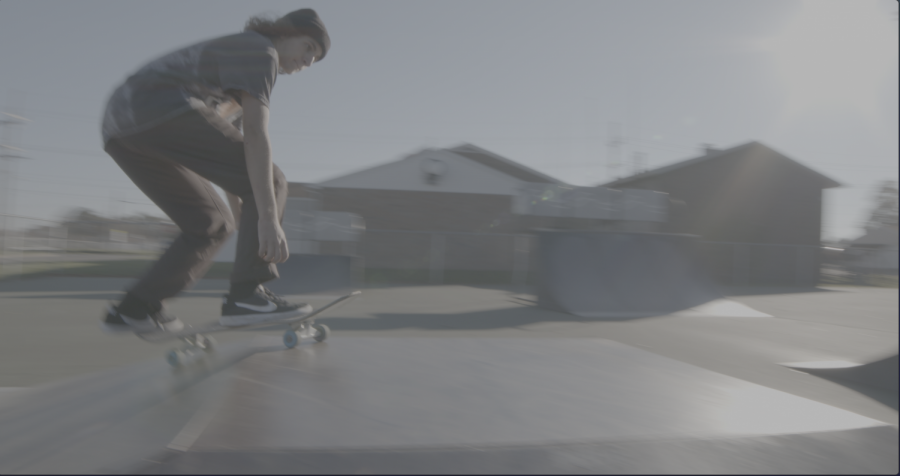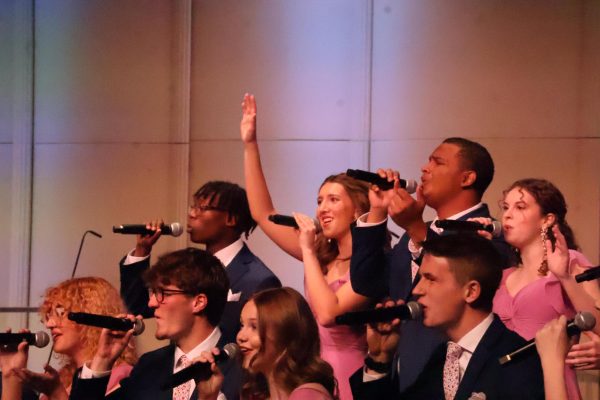Kick-Flip into relevance
Skating is making a comeback in the U.S.
Kristos Dallas at Dogwood Skate Park. Dallas has been skating for the past two years.
The stiff air of a crowded morning bus suffocates you, the dreary beginnings of the day make you feel sluggish, and by the end of the day, you are rife with exhaustion. However, as clouds grow thin, you leave your house with a skateboard. Every curb, railing and beat-up mailbox turns into a new challenge to overcome. A new trick to pull on your skateboard.
More people are skating around the school campus, be it their transportation to and from school, or to use GlenOak as a practice spot. The presence of skating has rapidly increased and is quite present in GlenOak High School.
Junior, Max Koske, a skateboarder of four years, has his own ideas on the uptick of skaters.
“Honestly I’m not entirely sure why it’s coming back, but if I had to guess it would be because it’s just something exciting,” Koske said. “There’s not really any rules which leads to a lot of creativity which draws people in. I think that skating comes with a great sense of community, everybody gets along with each other.”
The history of skating goes way back to 1735, when John Joseph Merlin invented his “wheeled shoes” for a party. A lack of innovation caused their fall in popularity. This changed when the wheel was reinvented. Waitresses started skating for drive-ins and skating as a whole completely remade itself. Soon after, the disco-era began in the ‘70s and ‘80s, and quad-skating became a staple of dancing queens everywhere.
In the ‘90s, with the rise of the grunge and punk scenes, aggressive skateboarding and inline skating supplanted the quad skates of previous decades. The primary culture of today’s skating came from that decade.
Skating continues to evolve. Its popularity can be seen through the X-Games, which is an extreme sports event that highlights skateboarding.
There is no denying the peak of skating was in the ‘90s. According to Skate Review, skateboard sales dropped approximately 2% every year since 2007. In 2017, the X-Games received a record-low 35% fewer views than the previous year’s games.
However, two unlikely sources have caused skateboarding to come back; the rise of social media video apps such as TikTok and Instagram coupled with a global pandemic. According to NPR News, the skateboarding industry is predicted to grow to $2.4 billion by 2025.
In a Washington Post article, Michelle Steilen, the owner of Moxi Roller Skates had to open up a second factory to deal with the substantial amounts of orders coming in. Steilen said that back in April 2020, they made 12 times their regular sales. Those numbers continue to rise for the company.
The surge of roller skating TikTok videos as of late continues to inspire more to try it out for themselves. With the lockdown, people were searching for something to do, roller skating and skateboarding happened to be two forms of that.
Local skater, Frankie Digiroloma has seen a correlation between social media and the popularity of skating.
“With social media, everybody’s posting clips and brands are getting bigger. I think social media is a big part of it,” Digiroloma said.
There is a whole community of people that enjoy sharing their love of the sport. The growth of the online and social media presence has worked wonders for the expansion of the skate community. Koske frequently watches other skaters’ clips posted on different social media.
“With things especially like YouTube being so accessible, it makes it easier for independent filmers and skaters to distribute videos without having to be affiliated with a major company,” Koske said.
Dedicated skaters will go through dozens of attempts on a single trick until they get it right. They work extremely hard to improve their tricks. People share blood and sweat through their continuous attempts, thus bonds are formed.
In Canton alone, there are two skate parks for skaters to take advantage of: Ninth Street and Dogwood Park. Dogwood Park has plenty of people there constantly, but it is not cared for and could use a few additional ramps and half-pipes to keep challenging skaters.
Ninth Street is constantly improving and always has skaters practicing. There are constantly new ramps and activities being built. They inspire skaters to try new tricks.
Kristos Dallas, a sophomore and a skater of two years is motivated to constantly improve. He frequently visits the two parks.
Skate parks have continued to house many aspiring skaters, it has become hotbeds for the gathering of a community and a hub for improvement.
With blossoming business and increasing cultural relevance, skating has risen again and from the looks of things, it will continue to grow.
Your donation will support the student journalists of GlenOak High School. Your contribution will allow us to purchase equipment and cover our annual website hosting costs.






